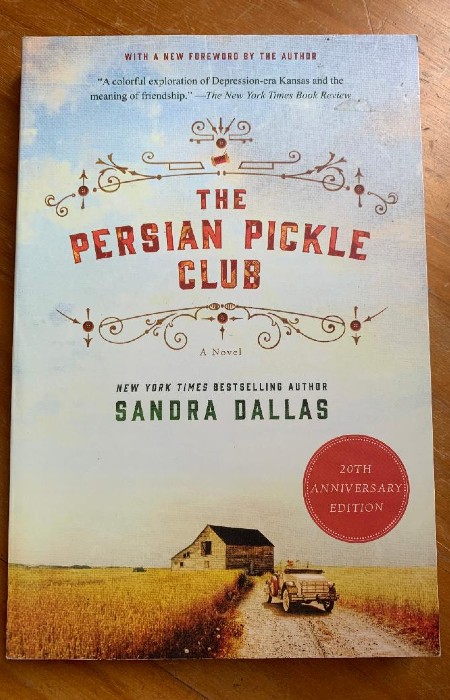
If ever there was a love letter to the power, surety and steadfast supportiveness of friendship, it is The Persian Pickle Club by Sandra Dallas.
First published in 1996, this much-loved novel came upon this reviewer’s path in a secondhand bookshop in Newtown, Sydney called Elizabeth’s in the form of a 20th Anniversary Edition whose blurb spoke glowingly about the transformative power of friendship for a group of rural woman in 1930s drought-struck Kansas.
In the midst of the worst pandemic in a century which, by necessity, meant a cessation of many of the social rituals we once took for granted such as catching up regularly with close friends, this slim but emotionally powerful novel struck a chord.
So sizeable a chord that while I am not in any way shape or form a 1930s rural woman from the American Midwest, I found a great deal with which to identify with a story in which friendship becomes the glue that holds people together in the face of some undeniably trying circumstances.
While the drought is an ever-present reminder of how tough their lives are, and the way in which their lives hang precariously in the balance, these women also must contend with the resurfacing of a dark secret long buried, one borne of their intimate connections and which must be dealt with using the same ties.
“‘Cheed was so happy she’d [Ceres Root] married him that he’d do anything for her. When he went to town one day, she asked him to bring her back a piece of fabric she’d admired. Instead of a length, he brought her back the whole bolt of cloth. It was Persian pickle, what some called paisley. Ceres still has a few yards of it left because it’s so precious to her. She’s particular about what she uses it for or who gets the scraps. Of course we all have pieces of it in our quilts. That’s how we’re called the Persian Pickle Club.'” (P. 42)
The apparatus for the nurturing of these close bonds is the Persian Pickle Club, a quilting circle that is so named because of a paisley pattern used in quilts called the, you guessed it, the Persian pickle, and which week in and week out sustains these women, not simply through the big, noticeable dramas but the small, daily ones which might go unremarked but which are never off their radar.
For many of them, it is the daily domesticity of life that proves most challenging, and while no one is in an abusive relationship as such, a fair number have husbands who are either emotionally disengaged or so weighed by the scarcity of the times that they have withdrawn inwards.
Queenie Bean, who is it is fair to say is the protagonist in what is in many ways an ensemble novel, is one of the lucky ones.
One of the youngest members of the club by a wide margin, she is, at twenty-three blessed with a husband in Grover who loves and adores in ways that many of the other woman envy.
She has her own trials to endure of course, one very personal indeed, but she finds sustenance and hope in the Circle who give her the kind of support and love that, though flawed at times (what friendships are not?), that makes getting through the hard times that little bit easier.

In a year in which friendships have mattered more than ever, even if their physical expression has been severely curtailed, The Persian Pickle Club is a delightful tale of the significant difference connections to other people can make in our lives.
For the women of the Circle, which includes matriarch Mrs Judd, her close friend Ella, Mrs Ritter and her daughter Agnes T. Ritter (she is always called this because it annoys a young woman who is prickly ay best, nasty at worst) and city newcomer Rita who has married Tom, favoured child of the Ritter clan, the act of quilting is as much about social cohesion and emotional support as it is about the practicalities of sewing quilts which are a necessary household item in an area where winters are cold and long.
The quilts though are also testament to the enduring power of friendship and family, and Dallas brings this evocatively to the fore in the The Persian Pickle Club which takes a pastime that many modern people might see as endearingly quaint and archaic and casts into a wholly new and illuminating light.
For without their weekly quilting sessions, suffused as they are with gossip, food and friendship, the lives of these remarkable women would be nowhere near as rewarding or meaningful.
For them quilting is often the difference between emotional life and death and while there are practical outworkings of their industry, the greater benefit surely is the binding of connections to each other which provide a bedrock of care and concern in those times when no one else is looking out for you.
“Grover and I looked at each other, not knowing what to expect. I felt a chill on my back as I wondered if Blue had had something to do with the man on the road, after all. We didn’t know the Massies very well, and they did have odd ways. But the minute I thought of Blue being tied up with that man, I knew I was wrong. I trusted the Massies almost as much as I did the members of the Persian Pickle Club.” (P. 162)
One thing that strikes you about the women of The Persian Pickle Club is how feisty and able to take care of themselves they are.
There is an enduring idea of rural women from times past as sweet, nice old ladies who wouldn’t stand up to a fly, but the fact of the matter is that the characters in The Persian Pickle Club are willing and able to stand up to everyone from the hopeless local priest who is more prone to lean on self-serving orthodoxy than selfless love and care to thoughtless, cruel husbands who don’t treat their wives the way they should.
Quilting might seem like a delightfully twee hobby to many twenty-first century readers, but in this novel it is empowering, binding, strength beyond measure and a social network that can stare pretty much anything stay and triumph.
That doesn’t mean to say it is unassailable, and there is a time in The Persian Pickle Club where it comes under some duress, but it is survives and keeps on, providing women who are desperately in need of it of the kind of life-changing friendship which transforms lives and makes a difference when precious little else is available.
The joy of this novel is that add muscularity and substance to our ideas of what friendship can be, trampling over, with warmth, high spirits and a feistiness borne of necessity, the idea that anyone is an old island and that they can exist successfully without others.
They cannot, and as you read The Persian Pickle Club that becomes clearer and clearer in a novel which celebrates how vital these connections between women can be and how they can endure, even in the most trying and life-sapping of situations,